What's New
Displaying results 3901 - 3910 of 4914
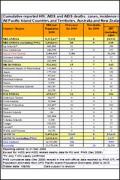
Resource | Publications,
Cumulative reported HIV, AIDS and AIDS deaths: cases, incidence rates and gender, plus cases with missing details; All Pacific Island Countries and Territories, Australia and New Zealand to December 2008

Resource | Guidelines,
The purpose of the National Strategic and Action Plan (NSAP) 2011-2015 is to guide the national response of Lao PDR to HIV/AIDS. The review and revision of the NSAP was participatory, and this document reflects contributions from government, civil society, people living with HIV and development partners. The NSAP is aligned with the 7th National Socio Economic Development Plan (NSEDP) 2011-2015, and the 7th Health Sector Plan. The National AIDS Policy and the National HIV/AIDS Law have provided the guiding principles and overall strategic direction for the development of the NSAP 2011-2015. WHO six building blocks framework has been brought into consideration for situation and response analysis in order to integrate HIV interventions into health system strengthening for the next year plan (see annex 8). On the other hand, the NSAP is also one among several efforts of the government that contributes to the national poverty reduction programme.
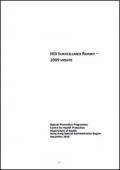
Resource | Publications,
Hong Kong, located in Asia the new burning place of HIV infection, is still having a relatively low prevalence of HIV infection. While sexual transmission is the predominant route of transmission in Hong Kong, an upsurge of infection in injecting drug users is a concern from the experience in other Asian localities. Various public health measures in Hong Kong have kept the HIV prevalence of drug users at low level, as compared with neighbouring cities.

Resource | Publications,
This publication reflects an important part of the World Health Organization’s (WHO’s) health sector response to HIV/AIDS and will contribute directly to the new Outcome framework of the Joint United Nations Programme on HIV/AIDS (UNAIDS).
The purpose of this document is to define WHO’s commitment to global and country support to scale up access to prevention of mother-to-child transmission (PMTCT) of HIV services and integrate these services with maternal, newborn and child and reproductive health programmes. The objectives included in this PMTCT strategic vision 2010–2015 illustrate WHO’s ongoing commitment to the United Nations General Assembly Special Session (UNGASS) goals on PMTCT and strengthening support for PMTCT within the context of the Millennium Development Goals (MDGs).

Resource | Publications,
This Strategy and Action Plan (2010-2014) was developed as a reference for all partners in the response to HIV and AIDS -- government, non-government, as well as international partners. At the national level, the Action Plan will be used as a tool to integrate HIV issues into national development plans, as well as serving as reference for government departments to develop more AIDS-related technical strategies. At the regional level, it serves to inform development of local AIDS Action Plans, which will serve, in turn, as the basis of local budget development. This document will also be used as an instrument to mobilize funds at the national and international levels.
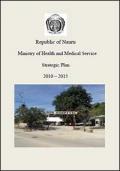
Resource | Publications,
The Health Strategic Plan outlines key strategies and activities that are in line with regional and international health initiatives. The plan is structured to incorporate key components of health system strengthening, primary health care and the Pacific initiative on Healthy Islands. The Strategic Plan has been developed after several consultations sessions with key units and staff of the Ministry and development partners. The plan is costed with the historical baseline budget amount and components for planning purposed. There are new activities proposed in the Strategic Plan that will need new funding and resource allocations.
The plan has the noble vision of "A Healthy and Peaceful Nation that values and supports human rights and dignity through the provision of quality health care and services". The plan also has linked mission and vision commitments and undertakings to the main vision statement. The HSP guiding principles relate to the regional and global commitment on health system strengthening, primary health care and healthy island revitalisation.
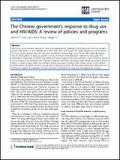
Resource | Reviews and Snapshots,
Illicit drug use has become popular in China. Acknowledging the challenge of illicit drug use, China has adopted several new policies on the management of illicit drug use in recent years. This study reviews the current policies on drug use and assesses the harm reduction interventions among drug users in China. The review documents that the new policies on drug use provide a variety of choices of detoxification treatment for drug users. The methadone maintenance treatment and needle exchange programs have been adopted as harm reduction models in China. Most of the reviewed harm reduction programs have been successfully implemented and yielded positive effects in reducing drug related risk behaviors among drug users. Although there remain barriers to the effective implementation of policies on drug use and harm reduction programs, Chinese government has shown their commitment to support the expansion of harm reduction interventions for drug users throughout the country.

Resource | Publications,
Universal Access is more than a time-limited aspiration that expires in 2010. It is—and will remain—a unifying principle for the HIV response. Achieving and sustaining Universal Access will be pivotal to progress towards the full array of Millennium Development Goals, including Goal 6, which calls for the world to halt and begin to reverse the HIV epidemic by 2015.
A sustained response to HIV requires the engagement of all sectors of society.
This report highlights WHO's contributions towards Universal Access in 2008 and 2009. It describes how WHO works and identifies specific achievements in each of the five strategic areas. While the organization's contributions to the HIV response draw upon the initiatives and expertise of WHO's six regional and 140 country offices, as well as roughly 30 different departments within WHO Headquarters, this report focuses particular attention on achievements of the HIV/AIDS Department in the 2008–09 biennium.
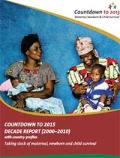
Resource | Publications,
The Countdown report for 2010 contains good news—many countries are making progress, reducing mortality and increasing coverage of effective health interventions at an accelerating pace. But the news is not all good. Many Countdown countries are still off track for achieving Millennium Development Goals 4 (reduce child mortality) and 5 (improve maternal health), and are not increasing coverage of key health interventions quickly enough. Countdown countries in Sub-Saharan Africa are especially far behind, although a few have shown improvements.
The vast majority of maternal and child deaths are preventable, but unacceptably large numbers of women, newborns and children are still dying each year in Countdown countries, where at least 95% of all maternal and child deaths occur. A growing proportion of child deaths occur in the first four weeks of life.
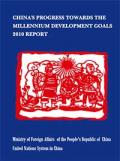
Resource | Publications,
In September 2000, 189 UN member states adopted the UN Millennium Declaration, formulating a series of specific goals for human development called the Millennium Development Goals (MDGs). These goals cover the economy, society, the environment and five other sectors. Most goals set 1990 as the baseline year and 2015 as the target year. The MDGs are now the most comprehensive, authoritative and clear-cut set of goals that exist towards the development of the international community.
Broadly recognized and actively supported by a wide range of parties, the MDGs have become an important standard for measuring the progress of global development and organizing international development assistance. Having set detailed targets and indicators for all the goals in the eight different areas, the UN regularly issues global progress reports that track achievements. In addition, the UN system works with member states to draft national MDG progress reports in order to raise awareness, stimulate discussion and promote further action towards implementing all goals. The Chinese Government and the UN Country Team previously drafted national reports on China’s Progress towards the MDGs in 2003, 2005 and 2008.





